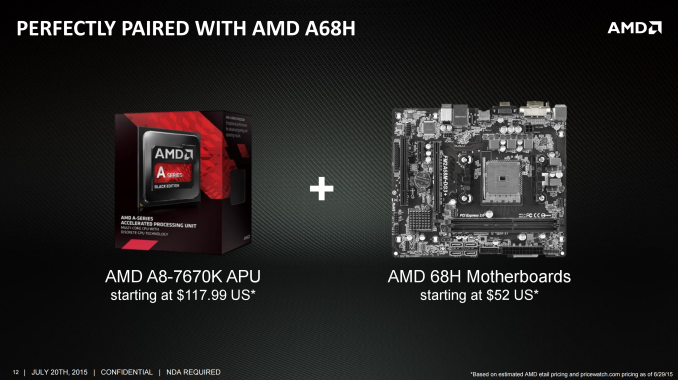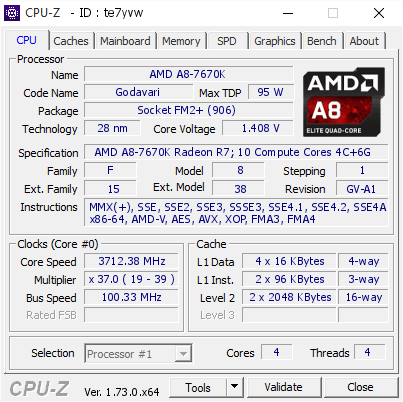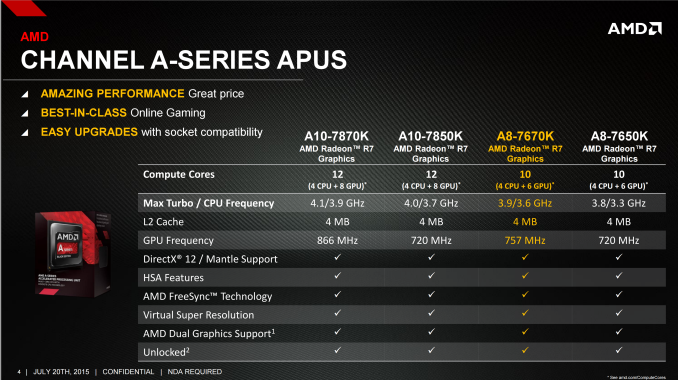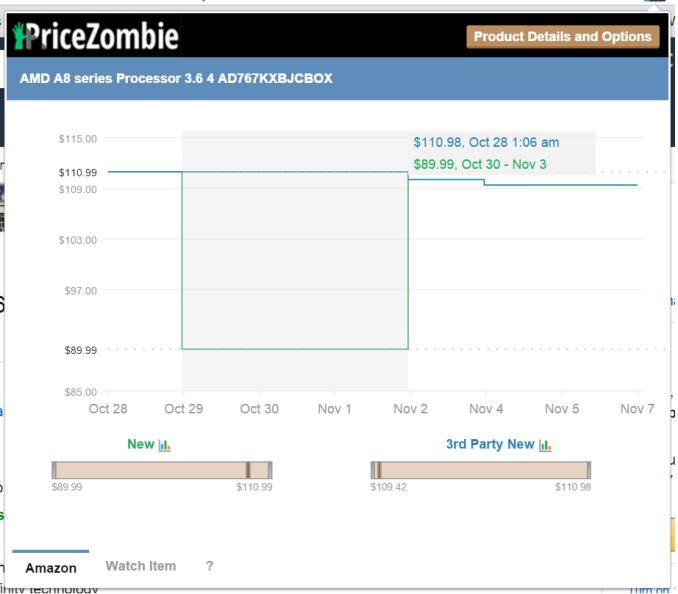The AMD A8-7670K APU Review: Aiming for Rocket League
by Ian Cutress on November 18, 2015 8:00 AM EST
Over the past couple of years, AMD has slowly released their mainstream brand of Kaveri processors. In turn, we have reviewed them, and they consistently aim to provide a midrange integrated gaming option, especially for those on a budget. The recent release of the A8-7670K was perhaps not that exciting, as AMD is filling up their product stack with new parts, taking advantage of an improved manufacturing process and aggressive binning. To that end, we're taking a different tack with this review. Alongside the regular tests, we also corralled Rocket League (an amazingly simple yet popular take on car football/soccer that sits on the precipice of e-sports glory) into a benchmark aimed at those sub-$600 gaming systems.
The AMD A8-7670K
Earlier this year, AMD announced their new line of Kaveri Refresh processors, starting with the A10-7870K (which we reviewed here). As the name suggests, these are Kaveri processors at their core, still based on the combination of Steamroller processor cores and 2nd generation Graphics Core Next (GCN) microarchitecture for graphics. These new refresh models are designed to take advantage of minor improvements in manufacturing, resulting in the ability to get higher clock speed for the same power consumption, even 18 months after the first Kaveri processors hit the scene. As a result, these Refresh processors — or, to use AMD's internal code name, "Godavari" — fill in the blank spots in the product stack and supersede the older parts, with the aim of squeezing in more frequency and performance for the same power consumption. It sounds deceptively simple — improve your process, refresh the part at the same price, and reap the benefits.
If we look at AMD's current lineup, we see that this new A8-7670K surpasses the older A10-7700K on the specification sheet, and comes in cheaper when brand-new.
| AMD Kaveri Lineup | ||||||||
| A10- 7870K |
A10- 7850K |
A10- 7800 |
A10- 7700K |
A8- 7670K |
A8- 7650K |
A8- 7600 |
X4 860K |
|
| Price | $137 | $134 | $131 | $120 | $118 | $104 | $89 | $85 |
| Modules | 2 | 2 | 2 | 2 | 2 | 2 | 2 | 2 |
| Threads | 4 | 4 | 4 | 4 | 4 | 4 | 4 | 4 |
| Core Freq. (GHz) | 3.9-4.1 | 3.7-4.0 | 3.5-3.9 | 3.4-3.8 | 3.6-3.9 | 3.3-3.8 | 3.1-3.8 | 3.7-4.0 |
| Compute Units | 4+8 | 4+8 | 4+8 | 4+6 | 4+6 | 4+6 | 4+6 | 4+0 |
| Streaming Processors |
512 | 512 | 512 | 384 | 384 | 384 | 384 | N/A |
| IGP Freq. (MHz) | 866 | 720 | 720 | 720 | 754 | 720 | 720 | N/A |
| TDP | 95W | 95W | 65W | 95W | 95W | 95W | 65W | 95W |
| DRAM Frequency |
2133 | 2133 | 2133 | 2133 | 2133 | 2133 | 2133 | 1866 |
| L2 Cache | 2x2MB | 2x2MB | 2x2MB | 2x2MB | 2x2MB | 2x2MB | 2x2MB | 2x2MB |
As it stands, the A8-7670K is a dual-module 3.6 GHz base frequency processor with a boost frequency up to 3.9 GHz. It comes with six graphics compute units, which translates to 384 streaming processors, similar to other A8 parts, but at a slightly higher IGP frequency of 754 MHz. The combined increase in processor and integrated graphics frequencies come at no extra cost in thermal design, with the A8-7670K at the same 95W TDP.
One of AMD's marketing strategies with these ~$100 processors is the price/performance angle. Aside from the integrated graphics, each of the AMD processors can pair with an R7 240 or R7 250 graphics card (DDR3 or GDDR5; AMD suggests an R7 250 GDDR5, as you might expect) in a hybrid dual graphics scenario, boosting performance. Thus, for the same price as an APU and an R7 250 graphics card, on average, AMD aims to offer a better gaming experience — especially for games that run at around 60 frames per second on medium settings — than a similarly priced Intel + NVIDIA platform. We've seen this marketing spiel corroborated in previous reviews, and would expect not to see anything different here. At launch, AMD put a $118 price on the A8-7670K, which, in recent sales, has been pushed down to under $100 at times.
The A8-7670K is an FM2+ socket processor, and thus requires either an A88X, A85X, A78 or A68 motherboard to go with it in order to take full advantage. As part of the launch, and given that this processor is a slightly boosted A8-7650K, AMD sees value in pairing it with something like a $50 A68H motherboard, making an APU+MB combination around $150 when on sale. However, as one might imagine, due to the age of the FM2/FM2+ socket, there are relatively few "new" motherboards on the market. The last one we reviewed was MSI's A88X-G45 Gaming, which brought over some of the components seen on its new Intel gaming motherboards, but other manufacturers have also put out M.2 capable AMD chipset-based motherboards as well.













154 Comments
View All Comments
jfelano - Monday, December 28, 2015 - link
Oh they were interested, they just didn't get the contracts cause AMD was on the ball and previous experience using AMD for consoles. Your talking billions of dollars, Intel was interested in billions of dollars believe me.JoeMonco - Thursday, November 19, 2015 - link
So the $158 million operating loss last quarter was due to making great business decisions?KranK_ - Friday, November 20, 2015 - link
AMD is in both consoles...and, yet they continue to NEVER make a profit. All AMD does is lose money, have you seen their quarterly financial reports? lmaoAlexvrb - Saturday, November 21, 2015 - link
Yeah if you look at them, you'll notice they're making money off the consoles. It's not nearly enough to offset the gushing losses elsewhere, but it is a positive flow of revenue. If they didn't have those sales, they'd be that much further in the hole.In fact, their console wins are probably the best thing they've done recently. They need to execute well with initial Zen-based designs and Arctic Islands alike. After that, they need to push HBM2 down into their APUs and to continue improving upon the foundation Zen has laid.
I'll be very interested to see what clocks they can hit while balancing power on the new node.
sld - Thursday, November 19, 2015 - link
Those who laugh at AMD are those who enjoyed the pricey new CPUs from Intel's near-monopoly.Kutark - Thursday, November 19, 2015 - link
Yes, and the excellent framerates that come with it. Oh did i mention how i paid ~$300 for a CPU 4.5 years ago and it still whips any 4core AMD can offer me? 4.5 years after the fact.If i had a bought an AMD in 2011 how many times would i have had to replace it by now? At least once, probably be due for another one. My 2600k even at stock speeds is faster than anything AMD can offer in a 4 core right now, and mines been sitting at 4.3ghz rock stable on air cooling since i bought it.
silverblue - Friday, November 20, 2015 - link
Four cores or four modules?fokka - Sunday, November 22, 2015 - link
good thing then that amd has been offering more than 4 cores in the consumer sector for quite a while.JoeMonco - Thursday, November 19, 2015 - link
Or we simply laugh at AMD because trainwrecks can be amusing.darkfalz - Saturday, November 21, 2015 - link
Intel has competition though - from its previous generation(s). They need to convince people to upgrade from a price/performance perspective.